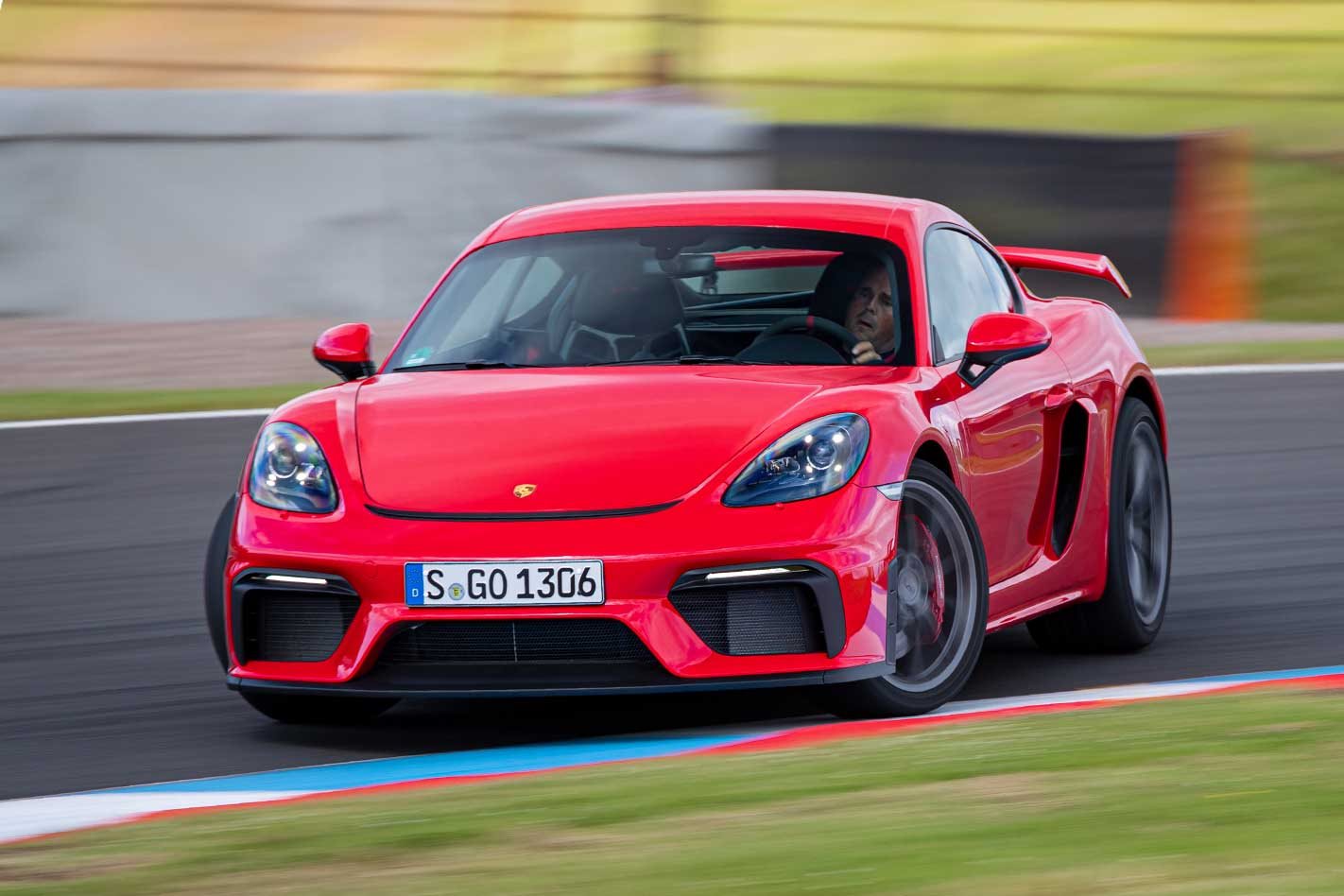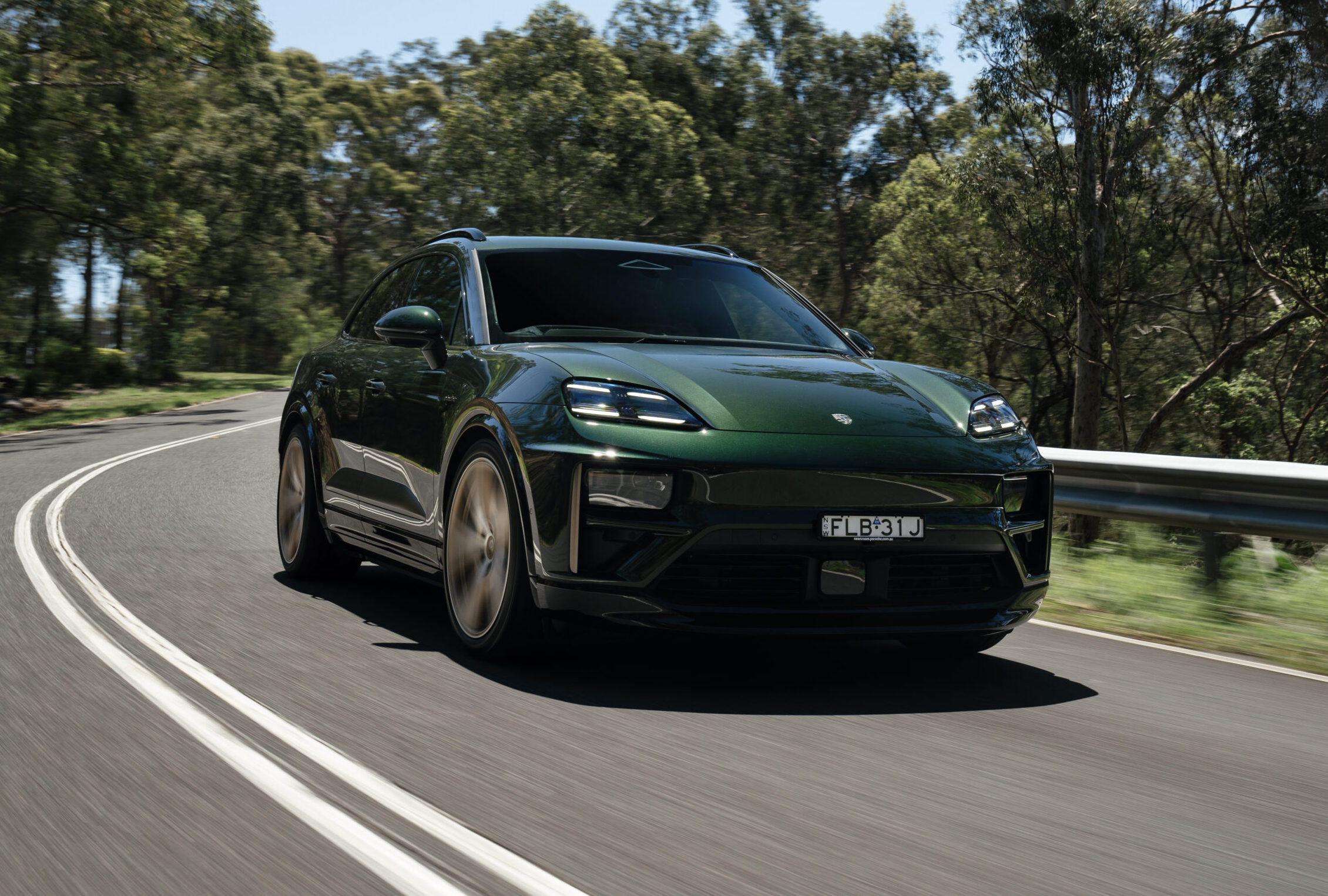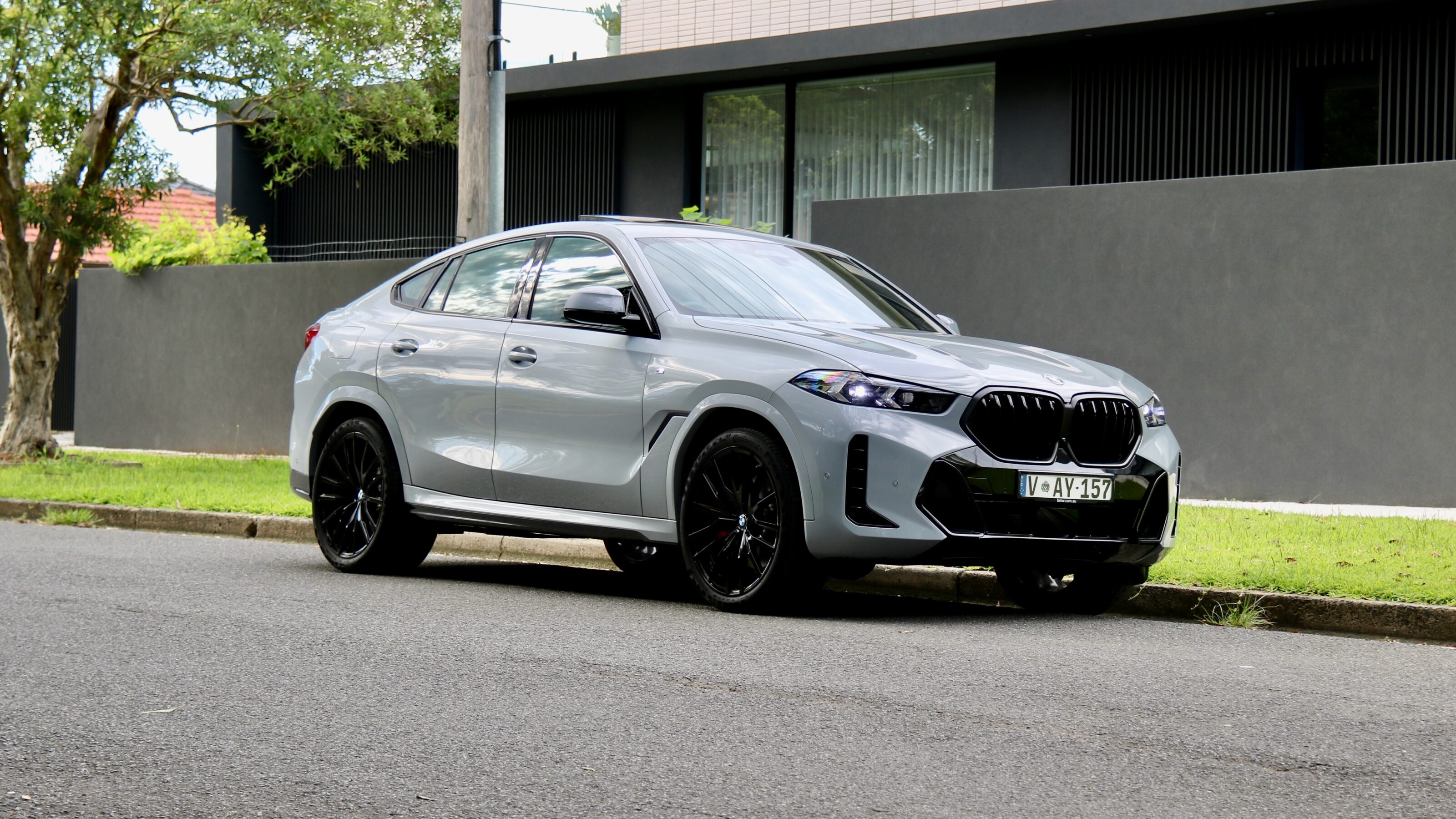The first Cayman GT4 arrived in 2015 as a near-perfect performance coupe, with the 3.8-litre naturally aspirated flat-six from a 911 Carrera S installed amidships – but it disappeared almost as quickly, demand quickly exceeding its limited supply.
Now it is returning as the Porsche 718 Cayman GT4, with more power, more downforce, and the promise of a dual-clutch option – and, prior to the open slather press launch, MOTOR was the first outlet in the world to drive it.

Increasing the engine capacity 200cc boosts power 26kW to 309kW at 7600rpm, just 400rpm shy of the redline and 200rpm higher than before – in keeping with Porsche’s desire for the GT4 to be revved even harder to deliver.
Although the previous 3.8-litre engine and the new 4.0-litre unit deliver an identical 420Nm, the oomph summit used to dwell at a slightly more relaxed 4750rpm, whereas it now kicks butt in the 5000-6800rpm bracket.
For now, the GT4 comes only with the six-speed manual gearbox, but next year the PDK transmission will become available and make the least expensive five-star Porsche complete. This will be a welcome addition because life is sadly not all about having fun in the twisties.
More often than not, you’re stuck in traffic, pottering along at 30-80km/h or inching forward in stop-and-go increments, so why not dial in your favourite streaming service, stick the lever in Drive and indulge in a slo-mo waft until the road clears?
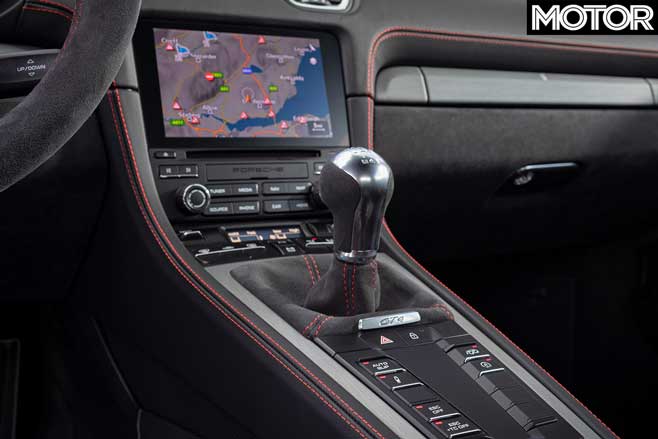
When defining the new GT4, Porsche thought long and hard about whether to cater exclusively for self-proclaimed purists. Late but not too late, they decided to offer the two-pedal dual-clutch arrangement in both GT4 models, starting in August 2020.
You can order your GT4 with Cup tyres, a partial roll cage and race buckets too tight to squeeze in the love handles. Alternatively, the car can be had with less extreme footwear – same size (245/35ZR20 and 295/30ZR20), but with superior wet grip – along with more comfortable 18-way sports seats or optional 918-style chairs.
Price in Australia will be around $200,000, which is a lot of dough for an evolutionary product. If I was in the market for a new top-of-the-line Cayman, I’d want a broader choice of colours and a discount for taking off that huge rear wing. If the Spyder doesn’t need it, why is it mandatory on the coupe?
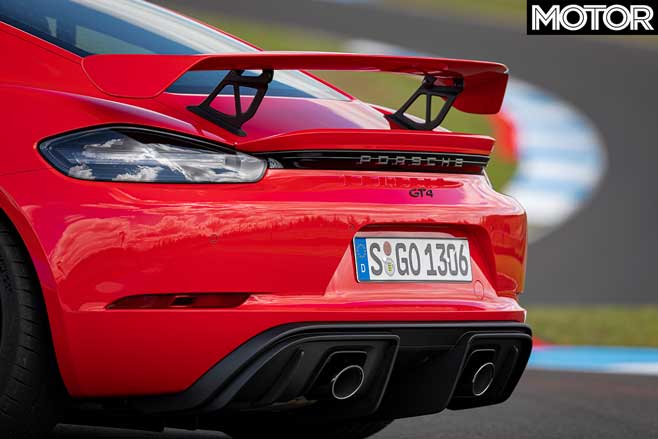
The upgraded suspension marks a big improvement. It is notably lighter, more rigidly connected to the body in places by metal uniball mounts, 30mm lower, and fine-tuned to match the stickier tyres, which were instrumental in clipping a full 12 seconds off the Nürburgring effort for a lap time of 7:28.
The 26kW power boost underlines the Cayman GT4’s dynamic personality, the revised aerodynamics work wonders for grip and stability, and the first-class chassis of the coupe is now also standard on the Spyder.
While the previous Spyder was little more than a modified 718 Boxster fitted with the GT4 engine, the 2020 model is the real McCoy. It looks significantly better, has a more practical watertight roof, is more generously equipped and at the same time cheaper than the coupe.
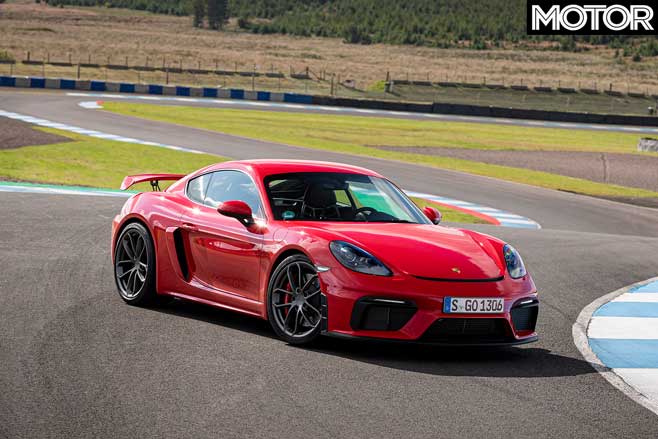
On the road, the new GT4 quickly reveals itself as the hard-revving machine Porsche promised. Hitting the limiter at 8000rpm in first is good for an indicated 84km/h, second cuts out at 137km/h, third stretches to 195km/h. That’s what happens when the GT skunkworks specialists lay their hands on that iconic normally aspirated flat-six.
This is definitely not an engine for the faint of heart, despite such compulsory CO2-friendly measures as the over-eager upshift arrow and impertinent idle-stop device. It’s best to ignore the tall gear advice because at 2000rpm in fifth or sixth this high-tech piece of art sounds like an assortment of silverware in the rucksack of a thief taking flight.
Mandatory high revs are not to everybody’s taste. Some users criticised the previous GT4 for its long-legged transmission, which kind of capped the unchecked urge above 200km/h, others loved it because the mix of zero throttle lag and ample mid-range torque rendered nine out of ten downshifts redundant.
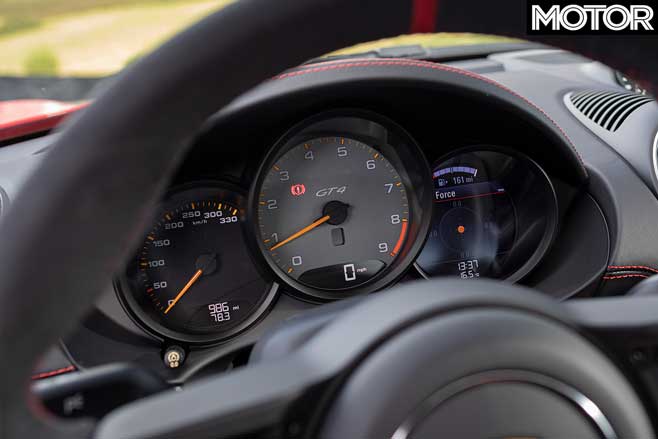
There’s no doubt the extra 200cc helps to offset the thermodynamic loss incurred by the compulsory particulate filter installed to meet the EU6d TEMP emissions. Despite the modified multi-stage high-pressure fuel injection, rerouted exhaust system (featuring one big transverse silencer instead of two separate boom boxes), voluble dual-stage intake manifold and the part-throttle cylinder cut-off device that downgrades the six to a three – what, only one cylinder bank at work in a red-hot Porsche GT! – the official fuel consumption rating is actually about five per cent higher.
The 309kW boxer is a high-tech engine through and through. Having said that, tip-in can be a little jerky when revs and ratio have drifted apart, tip-out is in this case coarser than expected, and the torque curve is a sleeper below 3000rpm, where it starts a swift climb to its zenith at 4600rpm. The power and torque lines intersect at 6250rpm, so there’s no real need to stage upshifts beyond 7000rpm.
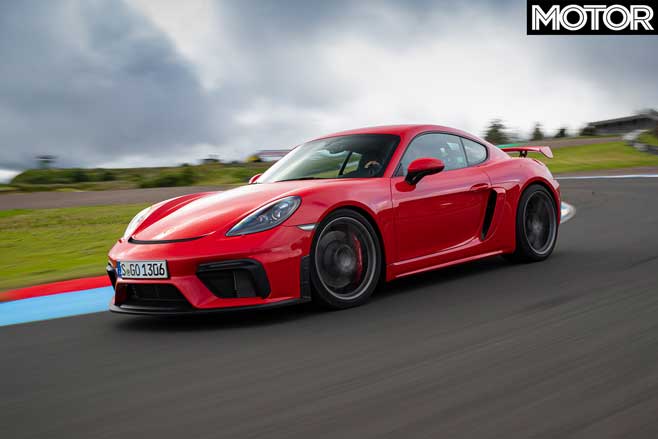
For some reason, maintaining smooth mid-range cruising speeds can be momentarily disturbed by split-second fits of restless throttle syndrome. Constant variation within a panoramic aural spectrum is what the catchy working noises are all about.
Solo parts include the trademark declutch clonk, the sotto voce intake chatter that enters fast-forward mode as the revs rise, fake heeling and toeing triggered by the puerile throttle-blip feature the marketing department insisted on, serious wind and road noise above 200km/h, and a rocket-in-a-tunnel full-bore exhaust note that can be fingertip-amplified for that special hooligan effect.
The difference in driving dynamics between the old Cayman GT4 and its successor is by no means instantly obvious. While the 4.4sec 0-100km/h acceleration time remains, top speed increases from 296 to 306km/h.
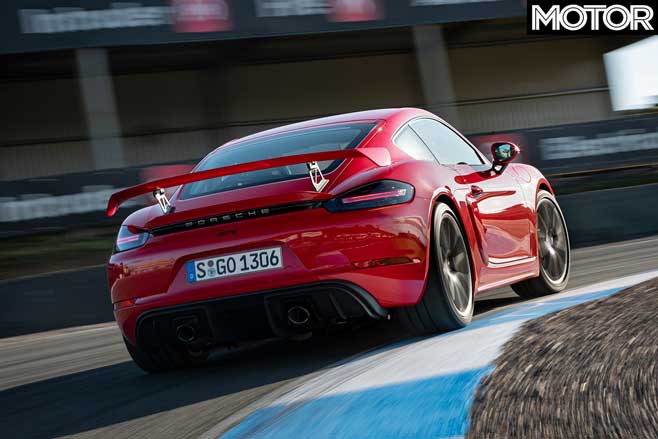
Since the drag coefficient remains unchanged, the top-end boost is exclusively due to the more potent engine and revised aero, featuring a larger chin spoiler, redesigned rear diffusor and more efficient tail rudder. Together, these aids beef up the downforce by a considerable 50 per cent.
“At the end of the day, it’s this subtle aero balance that makes the new GT4 so special,” explains Andreas Preuninger, the man behind Porsche’s GT division. “While it is important to keep the rear end firmly planted at any speed, front-axle lift must be proportionally reduced too. Done right, the result is a reassuringly stable vehicle even in adverse conditions. Confidence is key when it comes to exploring the limit.”
And the GT4’s limit is high. The g-force meter will regularly register over 1.0, the hard-working brakes devour tarmac, the second-gear, out-of-a-corner traction masquerades as all-wheel drive, and the ultra-high-performance Michelins provide phenomenal lateral grip. There’s no doubt about it – the Cayman GT4 still rules the kingdom of handling and roadholding.
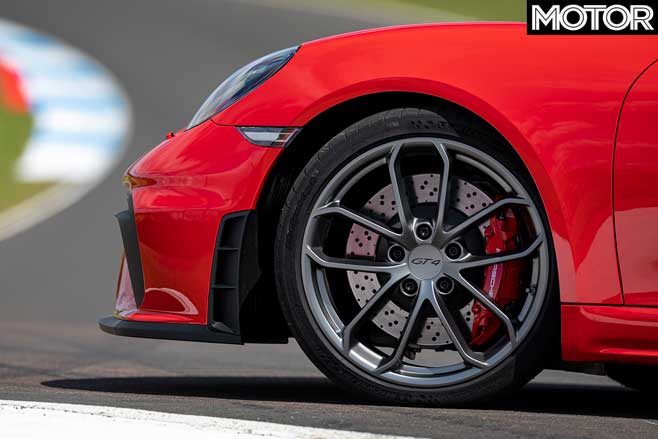
Like the version it replaces, this car is to the mid-engined fraternity what the GT3 is to the 911 class. In view of the less extreme weight distribution, one could even argue it is a sweeter and more balanced drive. But, because of the position of the engine, it also feels a little more ambiguous in the narrow demarcation zone that separates hanging on from letting go, which explains why PSM is again a two-stage affair.
For feedback and precision, nothing beats steering that is neither burdened by the weight of an engine nor handicapped by part-time propulsion duties. Predictably, this Porsche’s rack-and-pinion box is excellent, and the single-function Alcantara-wrapped three-spoke steering wheel – totally devoid of buttons and the need for distracting finger exercises – bonds man and machine to perfection.
In the Cayman GT4, it’s above all the steering that encourages you to take the backroads. Every turn-in action is rewarded, and winding off lock generates its own unique haptic dynamics, with such natural weight and gearing.
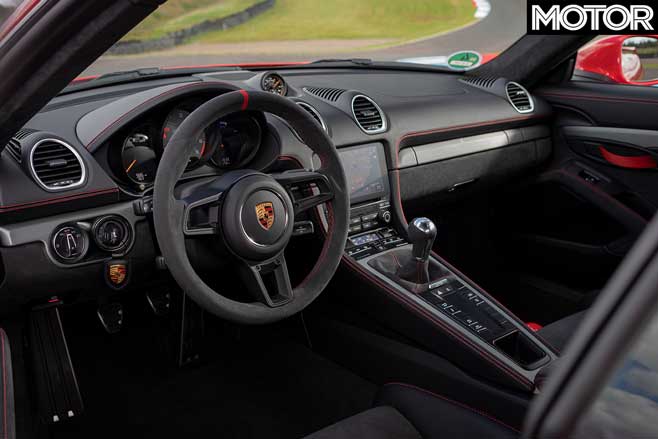
The awesome directional agility is backed up by a comforting calm over bumps, potholes, camber changes and longitudinal grooves. On sub-standard ground, the helm is soothingly well damped and detoxifyingly stressless. Needless to say, there are no computer-generated aids involved in plotting the chosen line.
Although I’d still prefer the PDK ’box, the retained six-speed manual is a classic. Compared to the awkward seven-speeder that survived in the 992, the Cayman’s DIY arrangement gets full marks for quick throws, accuracy and ease of use.
Praise also to the nicely progressive and sufficiently power-assisted clutch. But when you drive the GT4 in high-rev, knife-between-teeth fashion, upshifts must for the blink of an eye split massive momentums, which takes its time or the cogs will grind in anger.
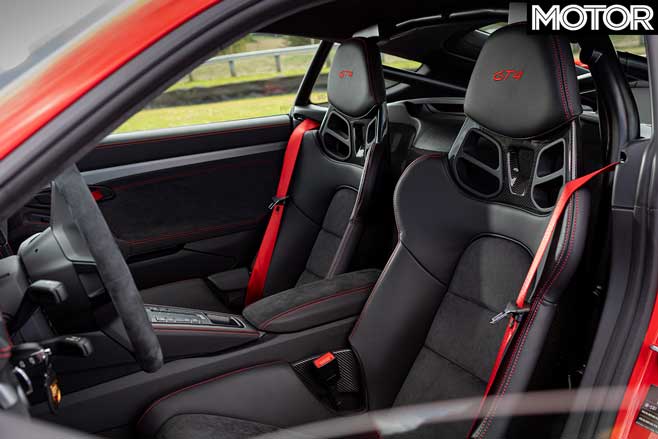
Although carbon-ceramic brakes are getting cheaper, they only make sense when the car in question spends enough time on track to justify the expense. If that’s not the case, don’t bother. After all, PCCB needs hot discs and pads to deliver, doesn’t like heavy rain and standing water, can be noisy in cold weather, and replacement parts will cost you an arm and a leg.
Our test car was fitted with yellow PCCB calipers, so we felt compelled to exercise the fade-free stopping power, relish the totally consistent pedal effort and marvel at the extra initial bite, all of which duly yellowed the complexion of my passenger’s face. At 1420kg, this featherweight Porsche is indeed the dream tool for notorious late-brakers.
The active damper system in Sport mode is firmer than in lesser versions. The combination of torque-vectoring and a mechanical diff lock makes the car more chuckable, while at the same time enhances traction. Although the front and rear strut suspension and both subframes are in essence carryover elements from the 991 GT3, the GT4 has its own set-up, which is less extreme but no less competent.
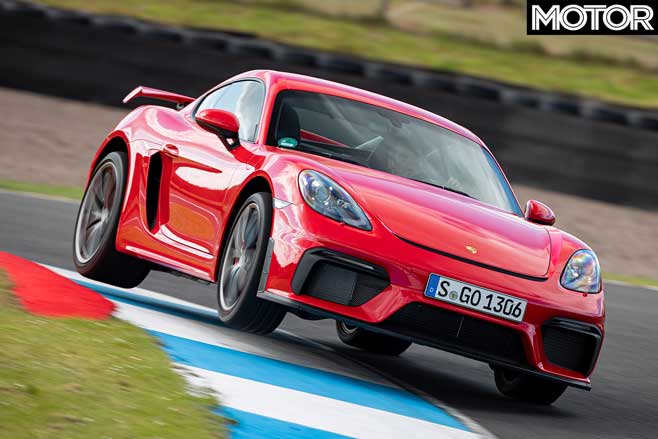
The Cayman GT4 is a more involving drive than the top-notch Toyota Supra, faster than the super-sweet Alpine, more challenging than the Audi TT RS, more complete overall than even the Jaguar F-Type R, and less compromised than a Lotus Exige and Evora.
But the Porsche is beginning to show its age. You still can’t have a head-up display, the infotainment dates back to the days of Game Boy, the archaic ergonomics are ho-hum and the traditional less-is-more approach to engineering doesn’t quite cut it in the age of electrification.
But we still love the GT4 because it’s not only a one-of-a-kind car but also a convincing last-of-line effort. After all, the next Cayman due in 2024 sheds the combustion engine in favour of a couple of electric motors while swapping the 64-litre tank for an underfloor battery pack. Here, then, is one of the last opportunities to purchase an old-school GT Porsche this side of the next-generation 911 GT3.
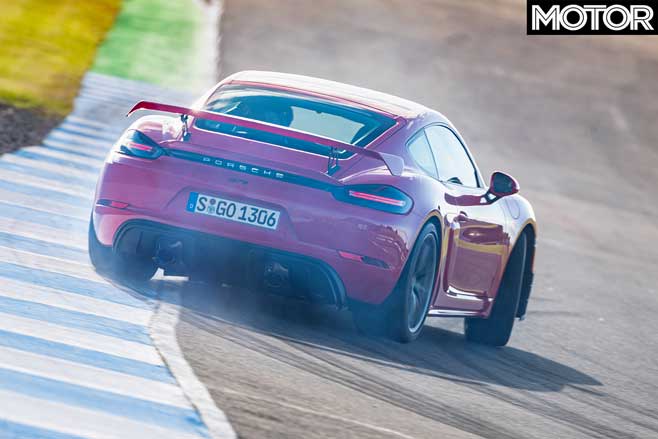
The Porsche Cayman GT4 is not so much about ultimate performance, and it really isn’t the best track-day special this kind of money could buy either. What it achieves with true greatness is to fuse and neutralise antagonisms such as ace handling and astonishing compliance, sharp handling and effortless controllability, emotional involvement and rational investment potential.
Using conventional means and minimal electronic assistance, this car achieves a remarkable balance of abilities. It can now fly with the fastest birds on the autobahn, is one of the most exciting backroad tarmac-peelers, absorbs surface vagaries and irritations like nothing else in its class, and is both forgiving and emboldening.
If driving satisfaction is all about maintaining the flow, finding the right rhythm and mastering the dialogue between input and response, then the GT4 perfectly matches this predator-prey scheme.
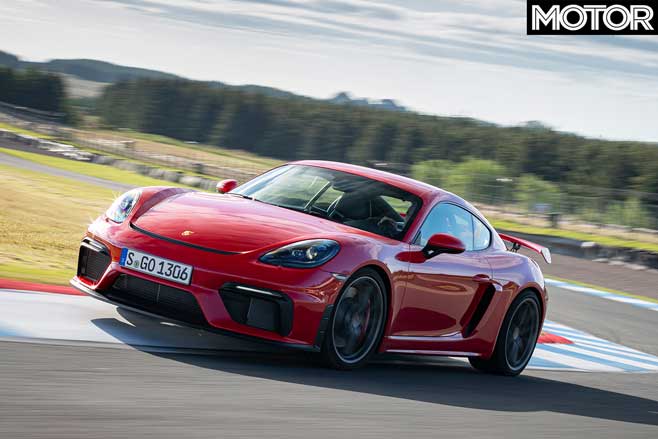
Back in 2014, we awarded the original car six points out of five, but time has moved on. While the second-season effort is every bit as competent and rewarding, it doesn’t really expand the envelope any further. It still rates five out of five, but only just.
Even though availability is this time reportedly not limited, it may be a good idea to hold your horses until the initial hype has ebbed away and the PDK option becomes available, perhaps even in combination with the Spyder, which could turn out to be the smarter buy. Whatever you do, think twice before trading in your old GT4 for the new one, because greatness is damn hard to improve on.

FAST FACTS 2020 Porsche 718 Cayman GT4 BODY: 2-door, 2-seat coupe DRIVE: rear-wheel ENGINE: 3995cc flat-six, DOHC, 24v BORE/STROKE: 102.0mm x 81.5mm COMPRESSION: 13.0:1 POWER: 309kW @ 7600rpm TORQUE: 420Nm @ 5000-6800rpm WEIGHT: 1420kg POWER-TO- WEIGHT: 218kW/tonne TRANSMISSION: 6-speed manual SUSPENSION: struts, adaptive dampers, coil springs, anti-roll bar (f); multi-links, adaptive dampers, coil springs, anti-roll bar (r) L/W/h: 4456/1801/1269mm WHEELBASE: 2484mm TRACKS: 1538/1534mm (f/r) STEERING: electrically assisted rack-and-pinion BRAKES: 380mm ventilated/drilled discs, 6-piston calipers (f/r) WHEELS: 20.0 x 8.5-inch (f); 20.0 x 11.0-inch (r) TYRES: 245/35 ZR20 (f); 295/30ZR20 (r) PRICE: $200,000 (estimated)
PROS: About as good as a driver’s car is ever going to get CONS: Time will tell if it lives up to the enormous hype RATING: 5 out of 5 stars

